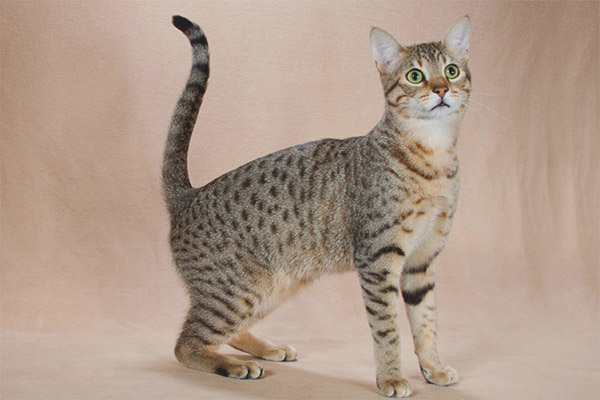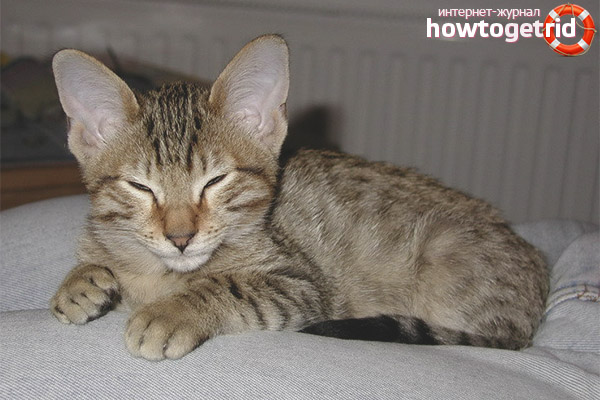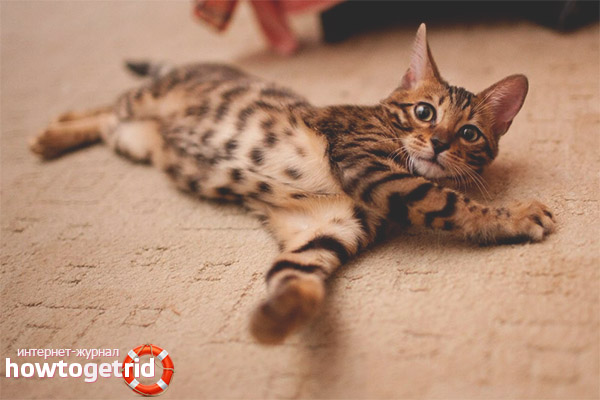The content of the article
Kanaani, or Kanaani is a relatively young breed. They were created for experimental purposes - seemingly a wild forest, but in fact a real domestic cat. The experiment was a success, the selection was successful, and the result met the expectations of the breeders. The noble appearance of these spotted cats is not rarely confused or equated with Savannah or Ocicat. In order to avoid doubts, it is necessary to know the exact characteristics of this breed.
History of origin
Israel, to be more precise - Jerusalem, is the birthplace of these cats. The name has biblical roots, the breed was named after the historic settlement of Canaan.
The discoverer of Kanaani is Doris Polachek. The sculptor, referring to both Russia and Israel, was the first breeder of the breed in the early nineties.
The first experimental breeds that participated in the interbreeding were representatives of the wild and domesticated cats. Subsequently, to improve the newly formed species, the blood of the Abyssinian, Shorthair, and Bengal cats was added. The result of this crossing and the Kanaani steel of this kind, which is known to the world today.
It took 10 years to present the final result to the world. After a while, there was a ban on crossing Kanaani with other breeds of cats.
Fact! The breed is recognized as official only in Germany, because it was there that they were bred for a long time.
Breed description Kanaani
Kanaani are cats of large and medium size, weight ranges from four to eight kilograms.
The WCF organization, which officially recognized these cats, gives the following description of the breed by standards:
- The head is medium-sized, triangular in shape, with clearly visible cheekbones. The forehead, in comparison with the muzzle, slightly protruding, the nose is absolutely straight, strong chin.
- The ears are large, far set apart. The base is wide, with pointed tips.Ideally, there should be more tassels, and a “print” pattern on the back of the ears.
- The eyes are large, almond-shaped. They have a slight slope and a wide landing. As for Oriental Kanaani, their eyes do not fit the standard of standards. The color is exclusively green. Deviation is allowed if yellow is present along with green.
- The body is athletic, muscular, but elegant. The neck has a length proportional to the whole body.
- The paws, both front and rear, are long, with an oval-shaped cushion. Due to the natural grace, gait, they resemble wild cats.
- The tail is elongated, of good thickness, which tapers towards the end.
- Wool medium coarseness, short length. Fitted tight enough, has a small undercoat. The length of each hair allows you to see the ticking of the underlying pattern. However, this does not affect patterns in the form of spots, which should be the most clear.
Character
Despite the wayward temperament, Kanaani are very loving and kind cats. Differ strong attachment to the owners.Stubborn and proud, but can afford to caress a little. Very smart, so there will be no problems with schooling rules.
The hind legs are very strong, so they jump a lot, any height is not an obstacle for them. Take care of the large space for Kanaani, because they have a lot of energy. Do not belong to the type of lazy cats, so most of their life passes in motion. Due to the great natural curiosity, they constantly strive to explore every place in the house.
Lonely pastime they do not like. Due to their friendliness, they will welcome a new neighbor, even if it is a dog. The friendly tandem of these two different types of domestic animals is very often very successful. The presence of another pet in the house will have a positive effect on the state of Kanaani. Accustomed to a sporty and active lifestyle, they will be much more fun if there is a company for this.
Care and health, nutrition
Given the fact that the breed is considered relatively young, there is no evidence as yet which diseases can be attributed to hereditary tendencies.
Many cats are susceptible to standard diseases. As an example, often, regardless of the breed, there is a tendency to kidney and stomach disease. In order to avoid further problems, you just need to be attentive to what can harm any vital organ of the cat.
You can take into account the Bengal breed, whose blood is present in Kanaani. Hypertrophic cardiomyopathy is a disease to which these cats are prone. They also have an increased sensitivity of the stomach. This is the only information on the basis of which it is possible to make assumptions about possible violations.
To eliminate the risk, you must be careful about feeding. It is not necessary to feed them with human food, even if it at first glance seems absolutely harmless. What a person uses without consequences may contain elements with which the cat will suddenly have incompatibility. Any salty, sweet or fatty food can adversely affect the state of the stomach.
The best option is a specialized cat food. If you have doubts about which one to choose - contact your veterinarian, he will select the appropriate food, based on the individual characteristics of the cat.
Kanaani do not suffer from obesity, on the contrary, due to high activity they spend a lot of energy every day. Food that contains proteins and carbohydrates with which combined feeds are enriched will help restore forces.
There are no special instructions for care, except those that are standard for any cat. Once or twice a week, comb, clean the mouth and ears, rinse eyes. A systematic visit to the veterinarian is an integral part of the content of any animal.
Color
Classic standard shade, which is allowed in color - between beige and brown. Mandatory pattern in the form of spots, or marble. A slight blur due to ticking is allowed. Based on the permitted shades, Kanami can have one of these colors:
- The usual spotted strength, or the spotted color of cinnamon.
- Normal marble forces, or marble colors of cinnamon.
- Chocolate spotted, or chocolate marble.
No other color, especially silver, can be approved by standards. Whichever of the above, the distinctive feature of Kanaak are the rings that twist around the tail end. It must necessarily ring at least three strips.It should also be black, like the pads. This feature was given to forestry cats. Neck describe the so-called beads. The quantity is possibly different, if one ring is not finished or torn, this is not a violation of the standard. The forehead is decorated with a clearly traced letter "M". The nose is brick-colored, with a red tinge, delineated by a line, which should be the same color as the general body color.
The cost of breed Kanaaki
If we consider the prices that offer sites for sales, then they begin, on average, from 800 to 1,200 dollars.
Where to buy Kanaani
This breed does not enjoy great popularity in the world. The main suppliers are Israeli and German breeders. On the territory of the United States of America, there are also connoisseurs of these cats, but there are very few of them there. As for the CIS countries, no one bred Kanak here.
There are many nurseries that offer breeds of similar appearance, but not Kanaaki themselves.
Ukrainian breeders are selling those breeds that were directly involved in crossbreeding. The result of which was the Kanaak breed. Among them are Abyssinians and Bengalis.













To send